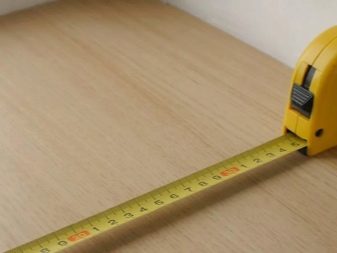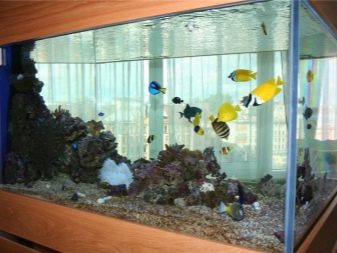How to calculate the volume of an aquarium?

The main mistake of a novice aquarist is the purchase of a home reservoir of insufficient volume. The aquarium is an independent, closed ecosystem with its own underwater world. The larger the volume of the tank, the more comfortable the life of the aquamir population and the easier it is to maintain the natural biobalance.


Why do you need to know the volume?
Before buying or for making an aquarium on your own, it is very important to know the actual volume of the aquarium in liters. As already mentioned, the number of individuals in the home pond, their comfortable living and the correct selection of filtering and lighting equipment depend on this. You need to know the exact volume in order to:
- calculate the optimal number of fish and plants;
- in case of diseases in the aquarium, correctly determine the right portion of the medicine;
- determine the required amount of soil and fertilizers.

What tools will be required to determine?
To calculate the capacity of the reservoir, we need:
- tape measure, you can also use a ruler or centimeter;
- a sheet of paper and writing materials;
- microcalculator, with its help calculations will be made.


Calculation methods
There are many types of domestic water bodies. The easiest way is to calculate the volume of a rectangular aquarium, problems may arise with the rest of the shapes. To calculate the capacity of a rectangular reservoir, we need:
- take measurements from the outside, measure the length, width and height;
- remember, and it is better to write down these numbers;
- the capacity of the aquarium is calculated by the formula length multiplied by the width and height, thus we get the outer volume;
- to find out the internal capacity, you need to measure the thickness of the glass, then multiply by 2 the obtained values, then subtract it from the previously obtained numbers, this will help to get the internal numbers;
- we substitute the obtained values into the formula that we used earlier, and we get the actual internal volume of water in the aquarium in cubic centimeters;
- for the convenience of calculations, we translate into cubic meters (1 cubic meter is equal to 1000 liters).

This calculation is only suitable for a rectangular tank. For other types of aquarium, the values need to be adjusted, the calculations are made as follows.
- Cylindrical shape - we measure the radius of the base and the height of the tank, subtract the thickness of the walls, then multiply the square of the radius by the height and by the number Pi. As a result, we get the volume. For a half-cylinder, the resulting value is divided by 2.
- Spherical - we take the radius of the ball, raise it to a cube, multiply by 4/3, multiply the resulting number by 3.14.
- Cubic - measure either side, subtract the thickness of the glass and convert to a cube.
- Hexagon - the distance from the middle of one of the sides of the aquarium to the center of the opposite side is measured, divide the resulting length by 2, subtract the thickness of the glass, and multiply the resulting value by the length of either side.




In order to calculate the volume of other forms of aquariums (triangular prism, octagon and others), you need to divide into simpler geometric shapes, calculate each of them separately and then add the results. There is another method for calculating the internal volume. It is uncomplicated and accurate, but quite time consuming. To do this, we need a container of a certain size (any can will do). To determine the actual capacity of the tank, simply fill with water from a measuring vessel. Multiplying the number of poured containers by its value, we get the volume of the tank.
When determining the real capacity of a home reservoir, it is imperative to take into account the thickness of the glass, the volume of which the heater, filter, algae, decorations and soil occupy. It is also worth remembering that the tank is never filled to the brim. These losses must be taken into account when purchasing a fish tank.
The larger the aquarium, the greater the difference between the actual volume and the stated volume.


How to choose the best aquarium?
The main questions, the answers to which are of interest to novice aquarists when buying a home reservoir, are the type, shape and volume of the tank. First you need to understand what kind of aquarium do you want to buy? By and large, aquariums are divided into 2 categories - freshwater and marine. We will not talk about the marine aquarium for now, because it is very expensive, troublesome and not for beginners. Consider home freshwater ponds. They are divided into several types.
- The biotope is a rather rare species. Since it repeats a piece of a natural reservoir, any natural ecosystem, for example, a stream, a lake, etc. Not everyone likes this and is designed to a greater extent for an amateur. But recently, such reservoirs are starting to come into vogue.
- Dutch. This reservoir is a plant aquarium, that is, with a large number of living plants, planted in terraces in a certain order.
- Scape. Aquascape is a biotope refined and transformed beyond recognition. Plants, stones and driftwood are used to decorate it.



- Rybnik. This is an aquarium in which only fish live, without living plants. Most often, this solution is used by designers to decorate interiors. There are no special requirements for these reservoirs. The main thing is good water filtration, since high-quality cleaning is the key to the health of fish.
- Pseudomore. This type mimics the marine environment using coral, sandstone, limestone, a large number of rocks similar to the sea, and various fish, mainly from the cichlid family, with a bright and variegated color.Live plants are usually not used in such aquariums. For lighting, you need to choose blue lamps that imitate the color of sea water.


After you have determined what type of aquarium you want to buy, the next step comes - this is the choice of the shape of the reservoir. Optimal for a beginner will be a tank of the correct shape, a cube or a parallelepiped. Why exactly are they? It is convenient to work with them, you can arrange any composition of the scenery you want in them, especially in a rectangular one. And it is much more convenient to clean the pond with the correct shape than the others.
There are also panoramic, corner and wall ponds. It is not recommended to choose round or cylindrical aquariums. They are quite difficult to maintain, and the fish are stressed in them. Also, in such a body of water, it is difficult to find a fairly convenient place for plants and equipment. And the final stage is the choice of the volume of your reservoir. Aquariums are small (up to 50 l), medium (50-300 l) and large (from 300 l).
Most novice aquarists are of the opinion that the smaller the aquarium, the easier it is to maintain. This point of view is fundamentally wrong. Large and medium-sized reservoirs forgive the beginner much more mistakes. At the same time, a tank with a small capacity will immediately respond to incorrect actions. For example, the fish were overfed, the food remained and precipitated, the water became cloudy right there. A small amount of beneficial bacteria is not enough, and trouble can come from where it was not expected.
Any disruption to the biological and nitrogen cycle will immediately become noticeable.

Medium-sized tanks are considered the most suitable for small apartments. In medium-sized aquariums, fish and other residents feel much more comfortable than in small ones. Also, several types of fish can already be added to such reservoirs, which are easy to care for. A large volume aquarium is indispensable for those fish accustomed to the ocean. The main task of the fish lover is to maintain a comfortable biobalance.
Try to learn more about the types of pets you intend to keep. The main problem with a large aquarium is money. It is extremely expensive financially to purchase. Also, a lot of money is taken up by maintenance and care. A small aquarium should not be chosen by beginners, but by people with some experience. The optimal volume of the first aquarium is from 50 to 100 liters.
Using these tips, you can choose a home reservoir that will be easy to maintain, will not bring you the hassle of caring for it, and will delight all family members for a long time.

In this video, you will find out what to look for when choosing the size of the aquarium.








